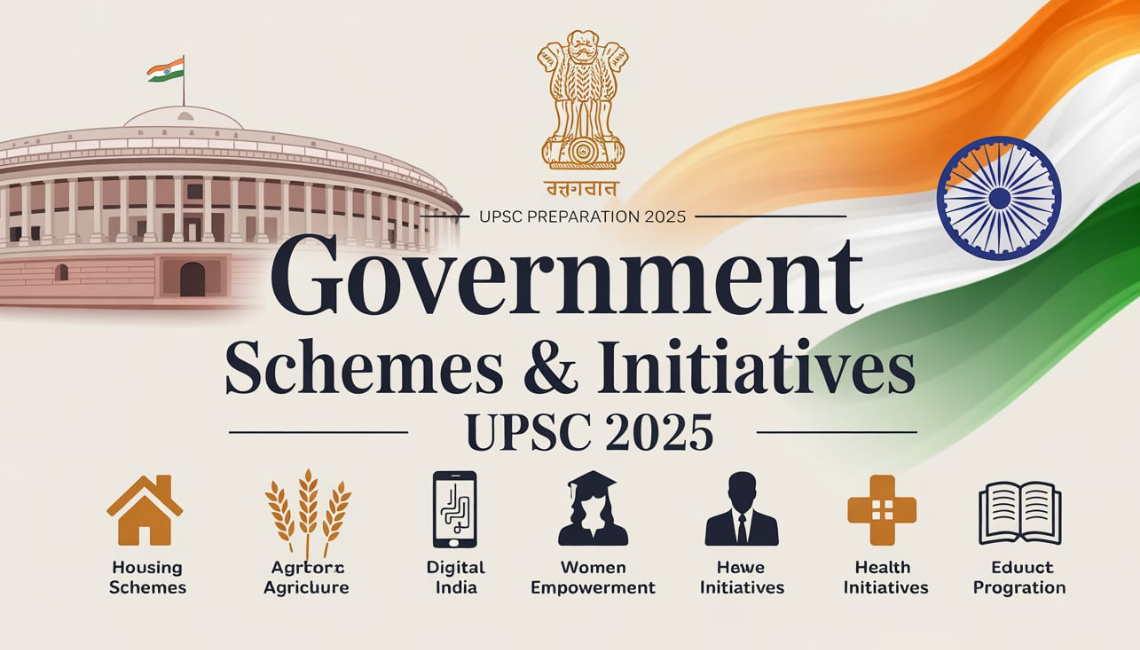UPSC aspirants must keep themselves aware of the recent government initiatives and schemes because they play a major role in the civil services prelims and mains examinations. 2025 has seen major developmental changes by the government, which are discussed as follows:
1.Health & Education: Expanding Capacity and Access
One of the major changes is the Union Cabinet's approval of adding 10,023 seats for medical education (MBBS and PG) across the existing medical schools and hospitals. This is a part of the government's plan to enhance healthcare infrastructure and combat the lack of medical professionals all over the country.
In higher education, the "One Nation One Subscription (ONOS)" scheme (under the Department of Higher Education) has attracted a lot of attention. Through ONOS it is estimated that around 6,300 of the government's higher education institutions as well as R&D centres will be able to access 13,000+ journals from around the world under the unified subscription model. The goal is to make it easier for people to access research resources, especially in cities that are tier-2 or tier-3.
In addition, the National Academic Depository (NAD) is in the process of being developed to digitize certificates of academic excellence and other records. This will decrease fraud, simplify verifications as well as support the country's Digital Vision.
2. Agriculture, Rural & Climate Interventions
Agriculture is seeing a renewed push, too. The Dhan-Dhaanya Krishi Yajana of the PM which was approved by the cabinet to be implemented across 100 districts over the course of six years, is aimed at accelerating the growth of agriculture and related sectors.
In the realm of environmental protection the Indian Bharat Forecasting System (BFS) was introduced in the month of May 2025 by the Ministry of Earth Sciences. With a grid resolution of six kilometers, BFS enhances meteorological prediction capability and is expected to enhance disaster preparedness and agriculture advisory.
3. Welfare, Inclusion & Women Empowerment
A variety of schemes target marginalized and vulnerable groups. In Odisha, the Subhadra Yojana was launched in September 2024 in order to empower financially disadvantaged women aged 21 to 60 who come from economically weaker segments. Beneficiaries receive cash transfers directly through Aadhaar-linked accounts for five years.
In the urban areas with poorer conditions, Uttar Pradesh is piloting the Deen Dayal Upadhyay Urban Livelihood Scheme across three district (Lucknow, Agra, Varanasi). Its focus is on creating job opportunities and linking families to entitlement plans.
At the level of the state, UP's Zero Poverty Campaign is noteworthy in that More than 13.5 lakh families with a low income have been identified as being connected to welfare schemes and livelihood programs which focuses on the development of skills for young people.
4. Urban, Infrastructure & Governance Reforms
The Smart Cities Mission, a long-running flagship project, officially ended on the 31st of March in 2025. According to reports from recent times approximately 7,479 of 8,058 projects that were submitted for consideration are complete, with Rs. 1.50 lakh crore of funds being utilized of the Rs. 1.64 lakh crore allocated.
Additionally under the Scheme for Special Assistance to States for Capital Investment (SASCI) the government of India has approved Rs. 3.6 lakh crore of 50-year, interest-free loans to states. This is a way to boost capital investment in infrastructure as well as public services.
On the national security and defense front, a recently announced initiative called Mission Sudarshan Chakra is aimed at developing an indigenous defense architecture that is advanced (akin to an air defense system) which integrates AI, cyber-capabilities as well as domestic manufacturing.
5. Key Takeaways for UPSC Aspirants
Draw a diagram of each sector such as education, health urban, agriculture, welfare, and urban. Introduce new schemes according to:
-
Concentrate on the features and number: e.g. 10,023 medical seats Rs. 3.6 lakh crore of state loans, a 6 Kilometer grids for BFS. This information will help to quote data in the mains examination.
-
Check implementation status & challenges: e.g. Smart Cities coming to an end with how many completed projects or pilot phases of the new schemes for welfare.
-
Link to broader topics: E.g. ONOS is linked with "research & innovation"; NAD connects the digital governance field; BFS to climate resilience Subhadra is a reference to the issue of gender equity.
-
Expect UPSC cross-linking. These plans are a good example in writing essays, governance responses as well as ethics-related subjects.
In summary, 2025 is shaping up to be a dynamo year for India's policy realm. The government is increasing its focus on education and health expansion as well as introducing digital and institutional reforms, as well as pushing welfare programs that have greater reach. For UPSC aspirants, the burden is not to just remember names, but also understanding the motivation, mechanism as well as the state of implementation and the policy implications of these programs.







